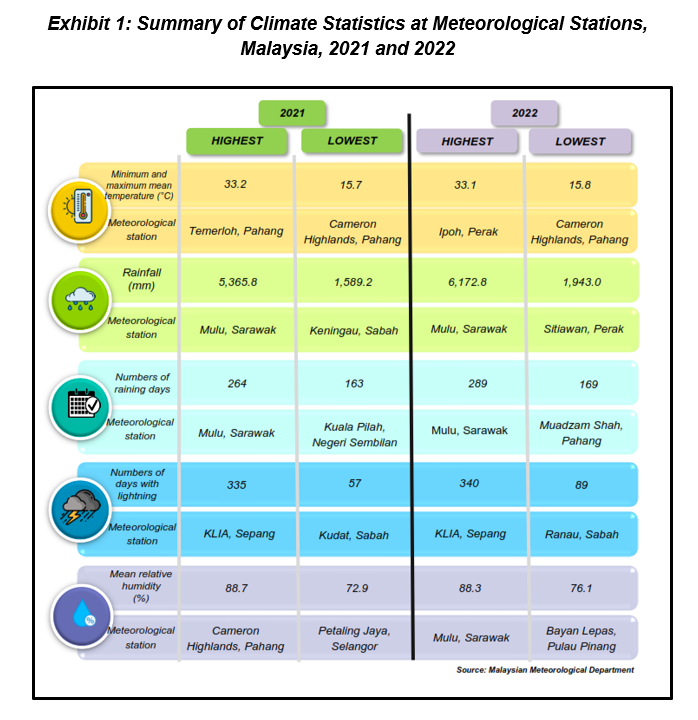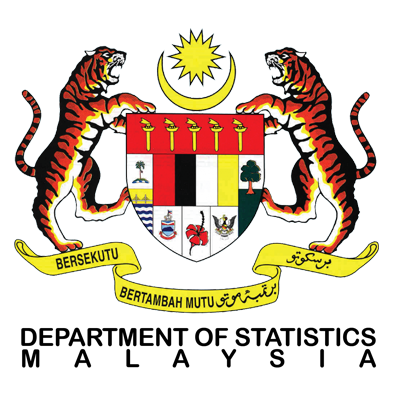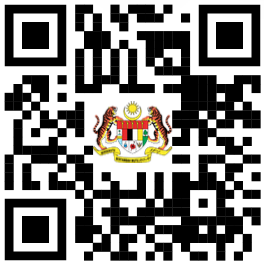Compendium of Environment
- Home
- Statistics
- Social
- Environment
- Compendium of Environment
Compendium of Environment Statistics, Malaysia
Compendium of Environment Statistics, Malaysia, 2022 29 November 2021
Compendium of Environment Statistics, Malaysia 2021 27 November 2020
Compendium of Environment Statistics, Malaysia 2020 29 November 2019
Compendium of Environment Statistics, Malaysia 2019 30 November 2018
Compendium of Environment Statistics 2018 28 December 2017
Compendium of Environment Statistics 2017 Show all release archives
Overview
In general, the opening of economic activities as well as climate change phenomenon have various effects on the environment in 2022. The changes in weather condition with heavier rain resulted one of the worst landslides in Malaysia’s history that occurred in Batang Kali on December 16th 2022.
The maximum mean temperature recorded from 42 stations showed a decrease in 24 stations between 0.1oC - 0.6oC while nine stations recorded an increase between 0.1oC - 0.3oC as compared to 2021 due to La Niña season. Ipoh station recorded the highest mean temperature in 2022 at 33.1oC, while Cameron Highland recorded a lowest mean temperature at 15.8 oC.
The annual rainfall in 22 stations showed an increase between 26.0 mm – 1,749.4 mm. Mulu station remained with the highest amount of rainfall at 6,172.8 mm in 2022 (2021: 5,365.8 mm). Meanwhile, the lowest amount of rainfall registered at Sitiawan station with 1,943.0 mm as compared to the previous year at Keningau station (1,589.2 mm). Kerteh station recorded the highest increase in rainfall with an increment of 1,749.4 mm to 4,501.0 mm in 2022 (2021: 2,751.6 mm).
In tandem with decrease in COVID-19 cases in 2022, Malaysia has reopened its borders and all economic activities and these have a direct impact on the environment. The COVID-19 cases declined from 2,645,076 cases in 2021 to 2,268,591 cases in 2022.
The decreased in COVID-19 cases led to reduced in the clinical wastes created as there were less usage of personal protective equipment (PPE) and COVID-19 test equipment following the closing of quarantine centers. The quantity of clinical wastes contracted by 14.4 per cent in 2022 to 49.1 thousand metric tonnes as compared to 57.4 thousand metric tonnes in 2021. This gives some relief for the management of clinical wastes site after two consecutive years of sharp rise. There were three states that recorded the largest amount of clinical wastes namely Selangor (10.6 thousand metric tonnes), W.P. Kuala Lumpur (5.8 thousand metric tonnes) and Sarawak (4.7 thousand metric tonnes).
In addition, the number of passengers handled at the airport
rebounded strongly after two years of hiatus due to the closing of borders as
one of the measures taken by most countries including Malaysia to contain the spread of COVID-19. The
number of passengers handled at the airport grew by 394.5 per cent due to base
effect to 54.9 million passengers as compared to 11.1
million passengers in 2021. However, the level achieved in 2022 remained below the
pre COVID-19 level registered in 2019 (109.5 million passengers). The
Tourist Sattelite Account (TSA) published by DOSM showed the same trend as Total
Gross Value Added of Tourism Industries rose to RM251.5 billion as compared to RM198.5 billion in 2021.


Data
- Table of Component 1 2023 - Environmental Conditions and Quality
- Table of Component 2 2023 - Environmental Resources and their Use
- Table of Component 3 2023 - Residuals
- Table of Component 4 2023 - Extreme Event and Disasters
- Table of Component 5 2023 - Human Settlements and Environmental Health
- Table of Component 6 2023 - Environmental Protection Management and Engagement
- Table of Comparison Between Countries
Subscribe
Newsletter
Subscribe to our newsletter and stay updated
For interviews, press statement and clarification to the media, contact:
Baharudin Mohamad
Public Relation Officer
Email: baharudin[at]dosm.gov.my
Phone: 03 8090 4681
Not found what you looking for? Request data from us, through
Go to eStatistik
Email: data[at]dosm.gov.my
Phone: 03 8885 7128 (data request)










